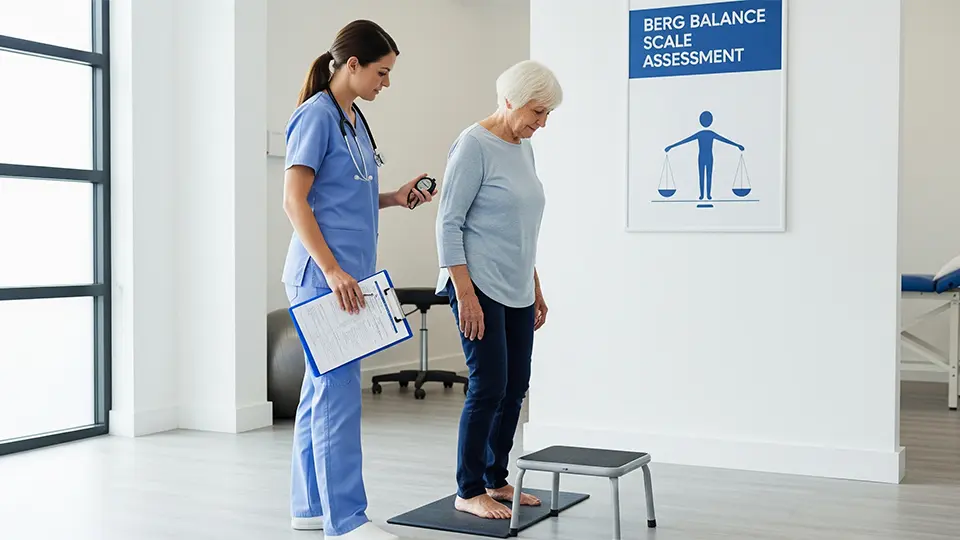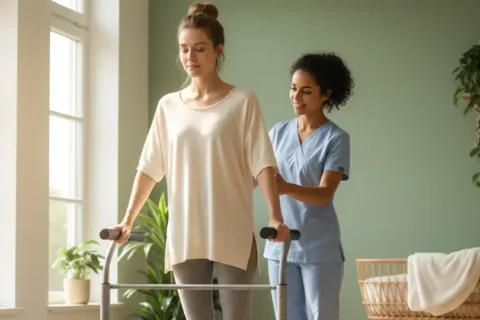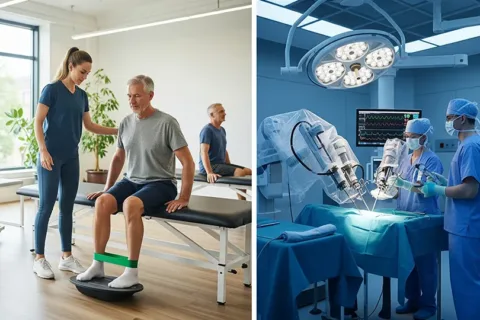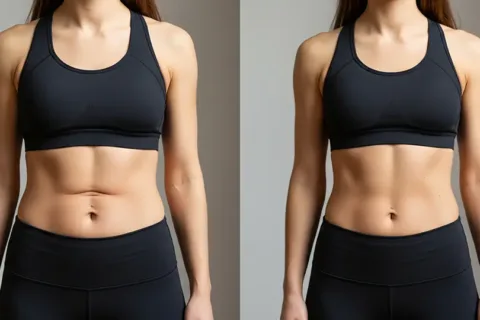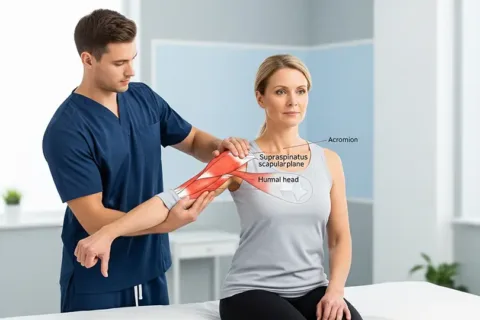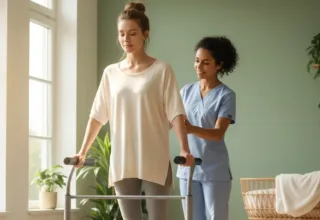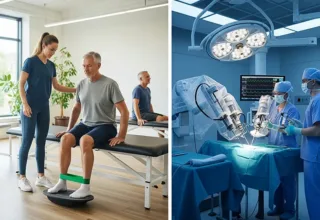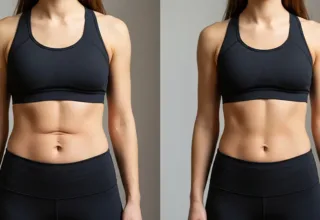Table of Contents
The Berg Balance Scale (BBS) is a gold-standard clinical assessment tool used to evaluate a person’s balance and risk of falling. Developed by Katherine Berg in the late 1980s, the scale was specifically designed to assess the balance abilities of older adults in a safe, standardized, and objective way. Today, it’s widely used by physiotherapists, occupational therapists, and rehabilitation professionals across various healthcare settings — including hospitals, outpatient clinics, home care, and long-term care facilities.
The test comprises 14 functional tasks that simulate everyday activities — such as standing up from a chair, reaching forward, turning, and standing on one foot. These tasks are carefully chosen to reflect the types of balance challenges individuals encounter in their daily lives, making the BBS both clinically relevant and practical.
What sets the Berg Balance Scale apart is its quantitative scoring system, which allows clinicians to monitor a patient’s balance status over time and to evaluate the effectiveness of therapeutic interventions. It’s especially valuable in the rehabilitation of:
Elderly individuals who are at risk of falls
Stroke survivors regaining functional independence
Patients with neurological conditions like Parkinson’s, multiple sclerosis, or traumatic brain injury
Post-surgical orthopedic patients, such as those recovering from hip or knee replacements
In this comprehensive guide, we’ll explore:
The step-by-step method to administer the BBS
How to score and interpret results
Clinical tips for implementation
Downloadable tools like score sheets and infographics
FAQs and evidence-based insights to improve your practice
Whether you’re a clinician seeking reliable outcome measures, a student learning about functional assessments, or a caregiver supporting a loved one in rehab — this guide will give you everything you need to use the Berg Balance Scale with confidence.
What is the Berg Balance Scale?
The Berg Balance Scale (BBS) is a standardized clinical assessment tool designed to evaluate a person’s static and dynamic balance abilities through a set of 14 performance-based tasks. Each task reflects a common daily movement that challenges an individual’s postural stability—such as standing on one foot, reaching forward, turning, or picking up an object from the floor.
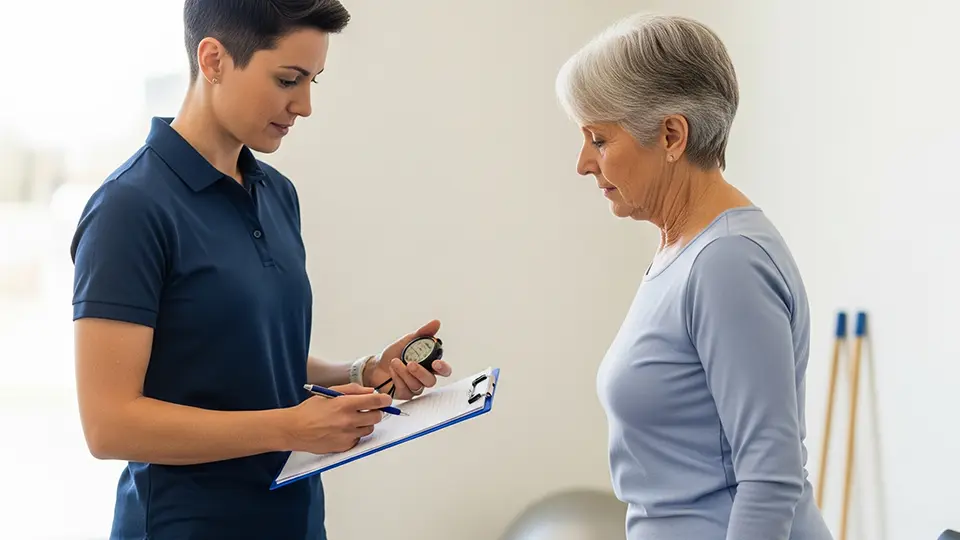
Developed by Dr. Katherine Berg, a Canadian physiotherapist and researcher, the scale was originally created in the late 1980s to assess balance in elderly individuals, especially those at risk of falling. Since then, it has become one of the most widely adopted functional balance assessments in physiotherapy and rehabilitation around the world. It’s frequently cited in clinical research, included in stroke rehabilitation protocols, and recommended by fall prevention guidelines globally.
🔍 How It Works
The test includes 14 simple tasks that assess balance while performing common functional activities such as standing, turning, and transferring.
Each task is scored on a five-point ordinal scale (0 to 4), with 0 indicating the inability to perform the task and 4 indicating independent performance without difficulty.
The maximum total score is 56. A score of below 45 is generally considered a sign of increased fall risk.
💡 What Does the Berg Balance Scale Measure?
The BBS provides a snapshot of an individual’s:
Postural control
Functional mobility
Anticipatory balance (e.g. reaching or turning)
Reactive balance (e.g. regaining position after movement)
Balance confidence and stability during daily activities
Unlike more technologically complex assessments, the Berg Balance Scale is simple, portable, and requires no specialized equipment, making it ideal for use in a wide range of settings — from hospitals and outpatient rehab centers to home visits and community health programs.
🧠 Who is it used for?
Although originally developed for geriatric populations, the BBS has proven valuable for assessing balance in many populations and clinical scenarios, including:
👵 Geriatric Assessments
Older adults naturally experience declines in balance, strength, and coordination. The BBS is commonly used to:
Screen fall risk in community-dwelling elderly
Monitor changes in balance due to aging or illness
Guide fall prevention programs and exercise prescriptions
🧠 Post-Stroke Rehabilitation
Stroke often leads to hemiparesis and impaired proprioception, affecting a patient’s balance and functional mobility. The BBS:
Helps therapists track progress through different recovery stages
Assists in discharge planning (home vs inpatient rehab)
Predicts fall risk and future functional independence
🧬 Neurological Conditions
People with conditions like Parkinson’s Disease, Multiple Sclerosis (MS), Cerebral Palsy, and Traumatic Brain Injury (TBI) often experience impaired balance. The BBS:
Identifies balance deficits and compensatory strategies
Provides objective data to guide treatment
Helps determine assistive device needs (walker, cane, etc.)
🦴 Orthopedic and Musculoskeletal Rehab
Even patients recovering from joint replacements (hip/knee), fractures, or chronic pain can benefit from the BBS:
Tracks progression during strengthening and mobility phases
Assesses readiness for community ambulation
Aids in return-to-activity decision-making
🏡 Home Health and Community Rehab
The BBS can be safely administered in home settings to evaluate fall risk and support aging-in-place plans. It’s a valuable tool for:
Visiting physiotherapists
Occupational therapists doing home safety assessments
Caregivers concerned about a loved one’s stability
📈 Why Is the Berg Balance Scale So Widely Used?
Evidence-based: Validated in dozens of peer-reviewed studies
Reliable: High test-retest and inter-rater reliability
Versatile: Suitable for multiple patient populations
Simple & Accessible: No fancy equipment required — just a chair, stopwatch, and a ruler
Actionable: Results directly inform treatment planning and risk mitigation strategies
Who Should Use the Berg Balance Scale?
The Berg Balance Scale (BBS) isn’t just a tool for physiotherapists — it’s a versatile assessment that serves a wide range of users across the healthcare spectrum. Whether you’re a clinical professional, a student entering the field of rehabilitation, a caregiver looking after an elderly parent, or a patient managing your own recovery, the BBS offers practical insights into balance, safety, and functional mobility.
Here’s how different groups can benefit:
👩⚕️ Clinicians & Physiotherapists
Primary Users:
Physiotherapists, occupational therapists, rehab specialists, geriatricians, and neurologists.
How It’s Used:
As part of initial patient assessment for balance impairments.
To track progress over time during rehabilitation programs.
To objectively quantify fall risk and inform safety planning.
To determine discharge readiness from inpatient rehab or hospital.
To develop individualized treatment plans based on balance deficits.
Example Use Case:
A neuro physiotherapist uses the BBS weekly to track improvements in a post-stroke patient’s balance as they progress from requiring a walker to independent ambulation.
Why It Matters:
Clinicians need validated, standardized tools to document patient outcomes.
BBS scores can be included in electronic health records, case reports, and insurance documentation.
🎓 Students & Rehabilitation Interns
Primary Users:
Physiotherapy, occupational therapy, and nursing students; interns and clinical fellows.
How It’s Used:
As a core practical assessment learned during coursework and clinical rotations.
To understand real-world functional mobility challenges.
To practice observational and scoring skills with supervised feedback.
As a training tool for developing patient communication and instruction delivery.
Example Use Case:
During a university lab session, PT students pair up and administer the BBS to each other to learn scoring nuances and improve observational assessment techniques.
Why It Matters:
The BBS is featured in national licensing exams and board certifications.
Mastery of such assessments builds clinical confidence and competence.
🧓 Caregivers & Family Members
Primary Users:
Sons, daughters, spouses, and home health aides caring for elderly or mobility-impaired loved ones.
How It’s Used:
As a simple, at-home check to monitor changes in an aging relative’s balance.
To detect early signs of fall risk or functional decline.
To communicate more effectively with health professionals by providing recent BBS scores.
To inform decisions about home modifications (grab bars, stair rails, non-slip surfaces).
Example Use Case:
A daughter notices her father struggling with turning and balance. She performs the BBS monthly and notes a 6-point drop, prompting a consultation with a physiotherapist.
Why It Matters:
Caregivers are the first line of defense in preventing falls and injury.
Understanding balance decline early helps prevent ER visits, fractures, and hospitalizations.
🧑🦽 Patients & Rehab Participants
Primary Users:
Individuals recovering from stroke, surgery, injury, or managing chronic conditions like Parkinson’s or MS.
How It’s Used:
To self-track progress during home exercise programs or therapy sessions.
To stay motivated by seeing tangible balance improvements over time.
To gain insight into their own physical limitations and strengths.
To advocate for appropriate assistive devices or care services based on score ranges.
Example Use Case:
A stroke survivor in outpatient rehab uses the BBS weekly with their physiotherapist and notices consistent gains of 2–3 points every session, reinforcing adherence to home exercises.
Why It Matters:
Empowering patients with data fosters engagement, accountability, and self-efficacy.
It builds understanding of how their balance affects daily living and independence.
✅ In Summary
| User | Purpose | Outcome |
|---|---|---|
| Clinicians | Diagnose and treat balance issues | Informed, evidence-based care |
| Students | Learn balance testing procedures | Clinical skill development |
| Caregivers | Monitor loved ones at home | Early fall prevention and peace of mind |
| Patients | Track recovery or manage chronic conditions | Greater control and awareness |
| Researchers | Study intervention outcomes | Reliable balance metrics |
How to Perform the Berg Balance Scale (With Detailed Instructions + Scoring Tips)
The Berg Balance Scale (BBS) is a 14-item test designed to evaluate a person’s ability to maintain balance during a series of predetermined tasks that reflect real-life functional movements. Each item is scored on a 5-point ordinal scale ranging from 0 (unable) to 4 (independent and safe). The maximum total score is 56, and lower scores indicate greater fall risk.
Here’s a complete breakdown of how to properly administer and score the Berg Balance Scale — whether you’re a clinician, student, or caregiver.
⚙️ Before You Begin: Setup and Equipment
You’ll Need:
A standard-height armless chair
A stopwatch or timer
A ruler or measuring tape
A step or stool (approx. 20 cm or 8 inches)
An object to pick up (e.g., slipper or pen)
A flat, quiet, and safe testing environment
Instructions for the Patient:
Encourage the patient to wear comfortable shoes and use their regular mobility aids (walker, cane, etc.) if needed.
Explain each task clearly before asking them to begin.
Always prioritize safety — stay close to prevent falls but avoid assisting unless needed.
📋 The 14 Tasks of the Berg Balance Scale
Each task should be performed once unless the patient appears unclear, in which case one repeat may be allowed. Here’s the full list of items, with instructions and scoring tips:
1. Sitting to Standing
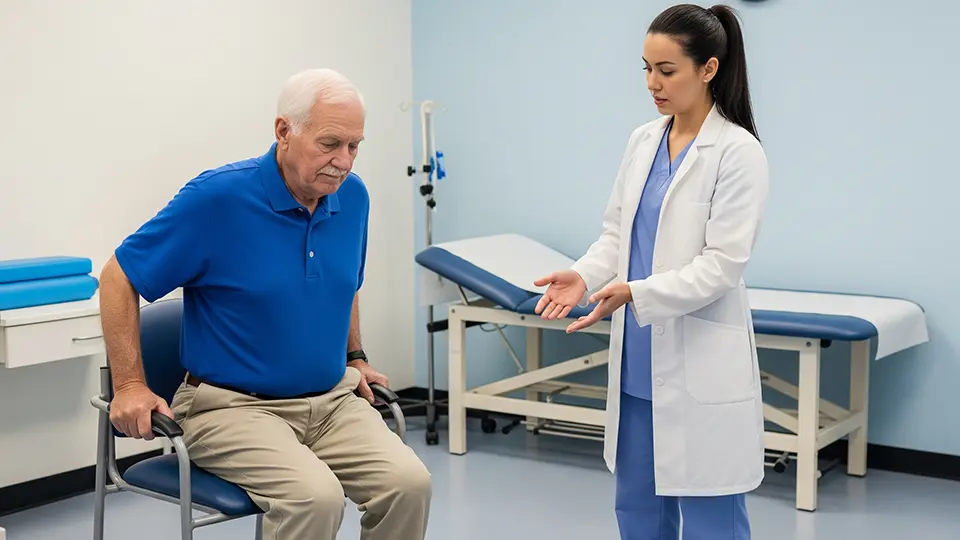
Instruction: “Stand up without using your hands if possible.”
Scoring Tip: Full marks (4) are given for standing up independently without using arms. Score lower if they require armrests, multiple attempts, or assistance.
2. Standing Unsupported

Instruction: “Stand still for 2 minutes without holding anything.”
Scoring Tip: Observe sway, need for support, and posture. Deduct points if arms are flailing or patient touches objects to steady themselves.
3. Sitting Unsupported
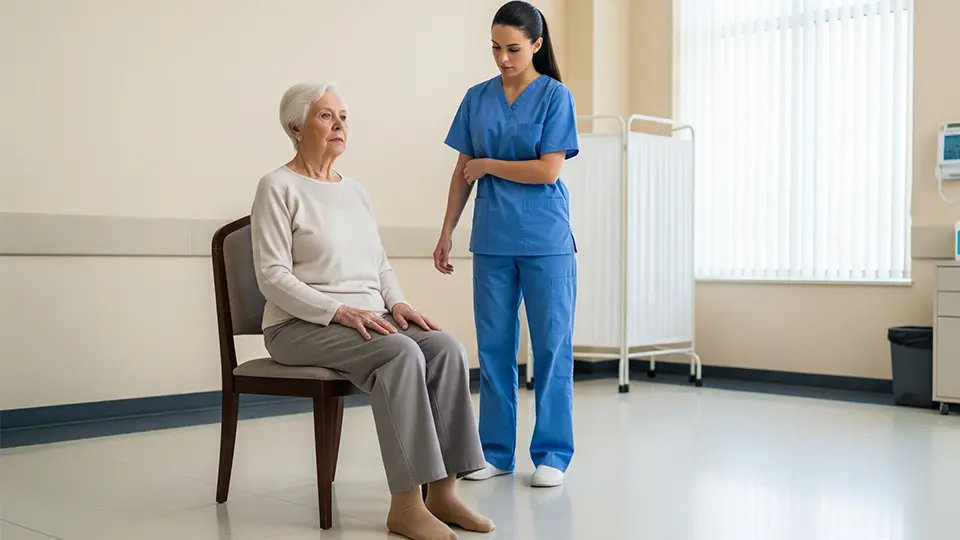
Instruction: “Sit without back support, feet flat, arms folded across chest, for 2 minutes.”
Scoring Tip: Look for trunk stability and posture. Leaning or requiring back support reduces the score.
4. Standing to Sitting
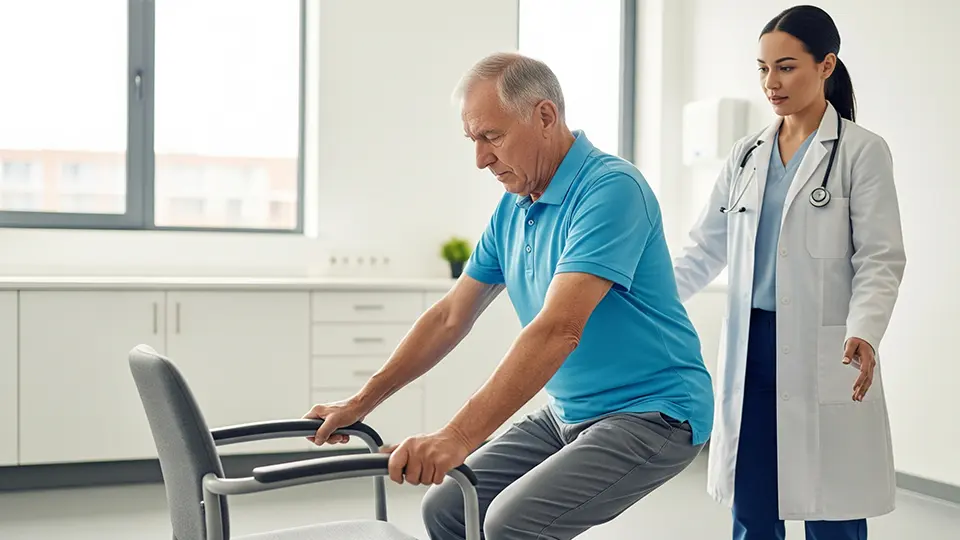
Instruction: “Sit down slowly and safely without using your hands.”
Scoring Tip: Control is key. A sudden “plop” into the chair, or needing to hold onto the chair, reduces the score.
5. Transfers
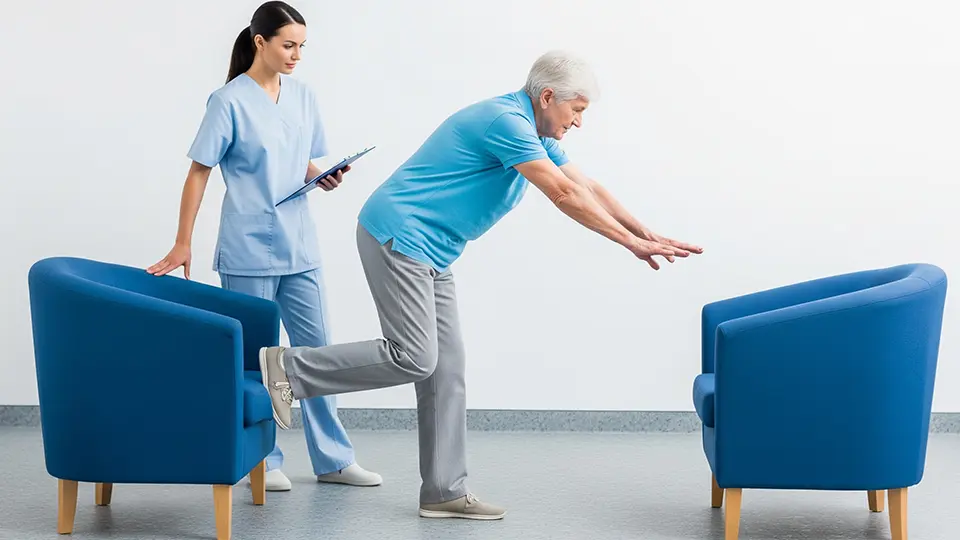
Instruction: “Move from one chair to another and back safely.”
Scoring Tip: Use two chairs (one with arms, one without). Score based on fluidity, control, and safety. Multiple attempts or unsteadiness means a lower score.
6. Standing Unsupported with Eyes Closed
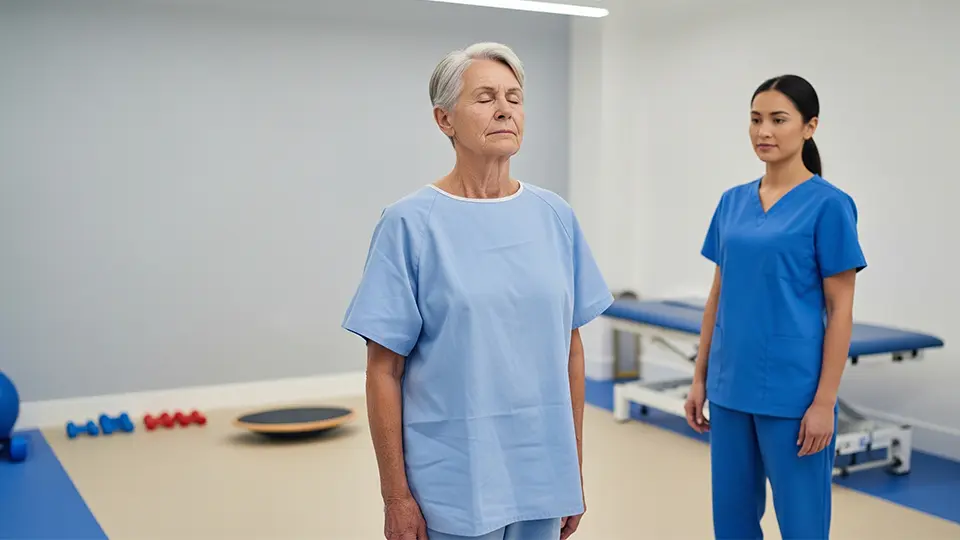
Instruction: “Close your eyes and stand still for 10 seconds.”
Scoring Tip: Be alert for increased sway or instability once vision is removed.
7. Standing Unsupported with Feet Together

Instruction: “Bring your feet together and stand still for 1 minute.”
Scoring Tip: This reduces the base of support. Swaying or stepping out of position decreases the score.
8. Reaching Forward with Outstretched Arm
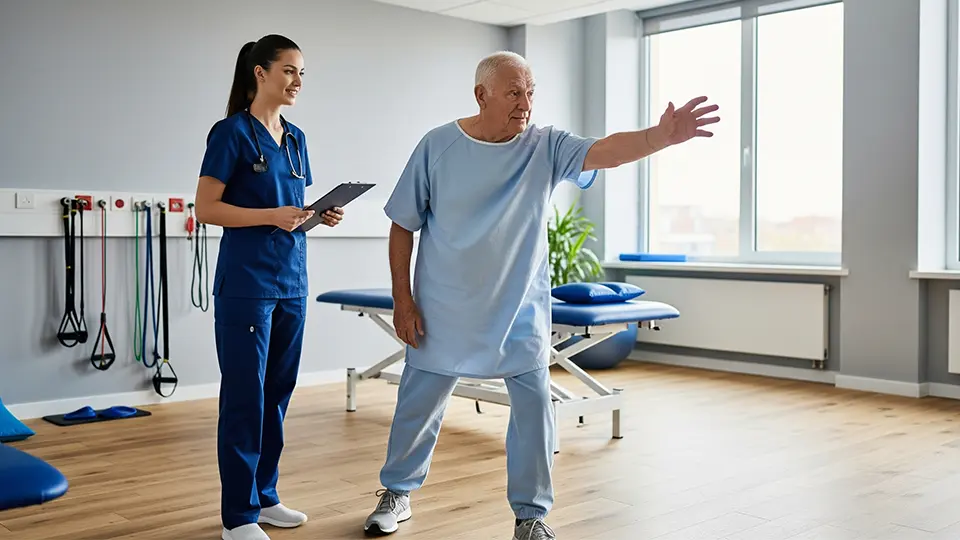
Instruction: “Stretch your arm forward as far as you can without stepping or losing balance.”
Scoring Tip: Use a ruler to measure distance. A reach of 25 cm (10 in) or more with control gets a full score.
9. Retrieving Object from Floor
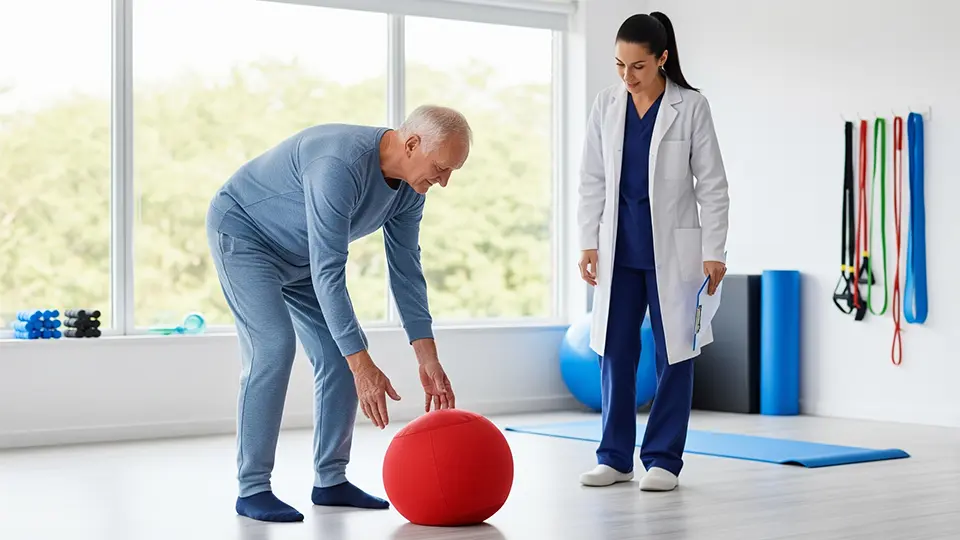
Instruction: “Pick up the object (e.g., slipper) placed in front of your feet.”
Scoring Tip: Points deducted if the patient uses support, loses balance, or cannot reach the floor safely.
10. Turning to Look Behind (Over Shoulders)
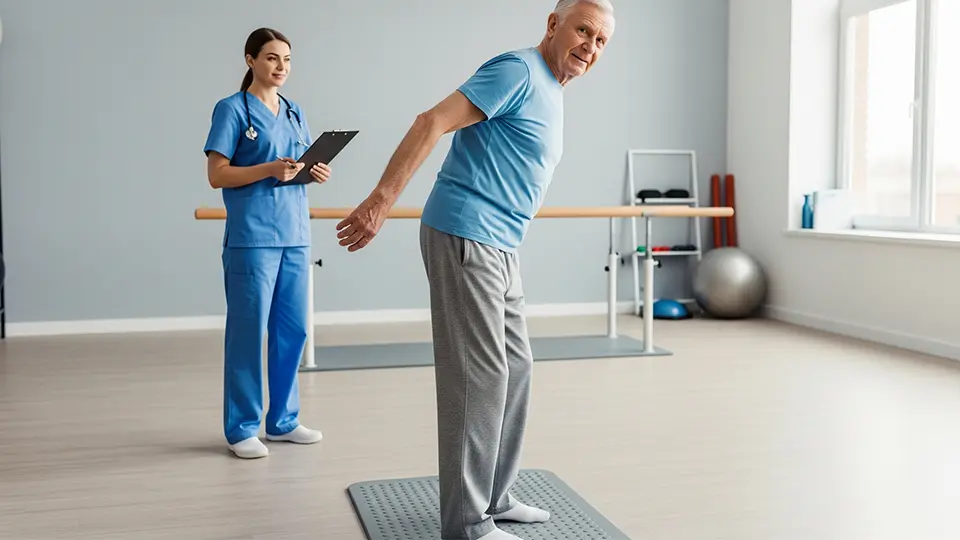
Instruction: “Turn and look over your left shoulder, then your right.”
Scoring Tip: Watch for foot movement, loss of balance, or needing support.
11. Turning 360 Degrees

Instruction: “Turn completely around in a full circle and then return the other way.”
Scoring Tip: Points reduced for taking too many steps, losing balance, or being unsteady.
12. Placing Alternate Foot on Stool
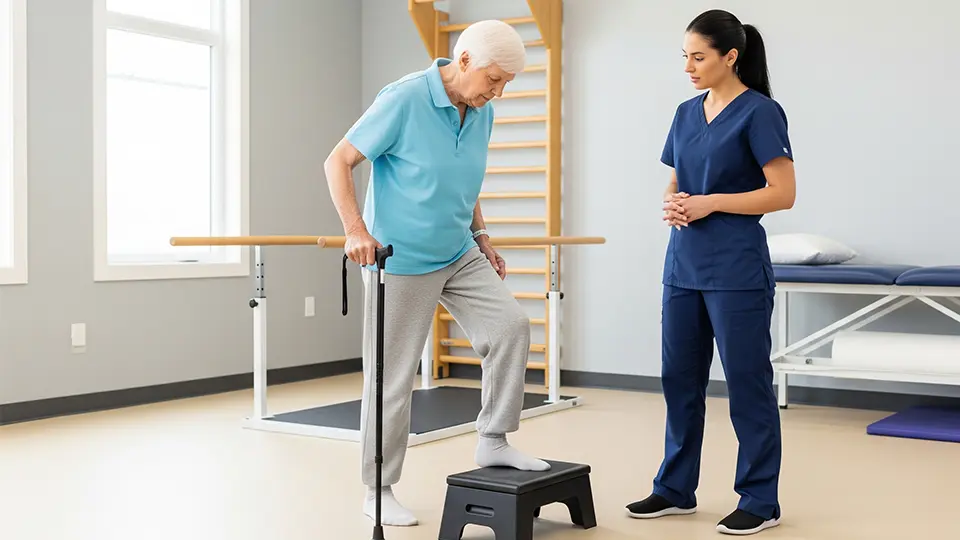
Instruction: “Place each foot alternately on the stool, like marching in place.”
Scoring Tip: Ensure correct height (approx. 8 inches). Deduct for hesitation, arm support, or poor control.
13. Standing Unsupported with One Foot in Front
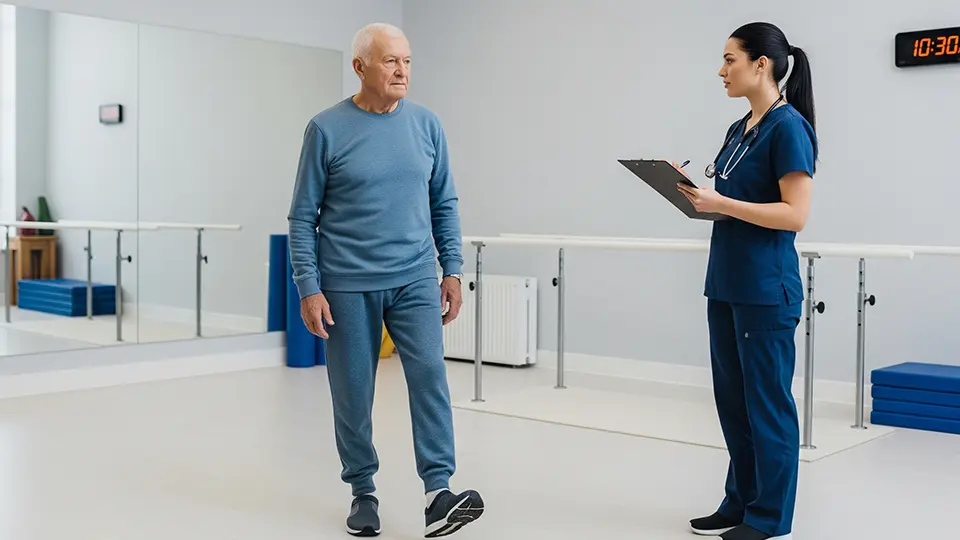
Instruction: “Place one foot directly in front of the other and hold for 30 seconds.”
Scoring Tip: Also called the “tandem stance.” Lower scores if unable to position or hold stance.
14. Standing on One Foot
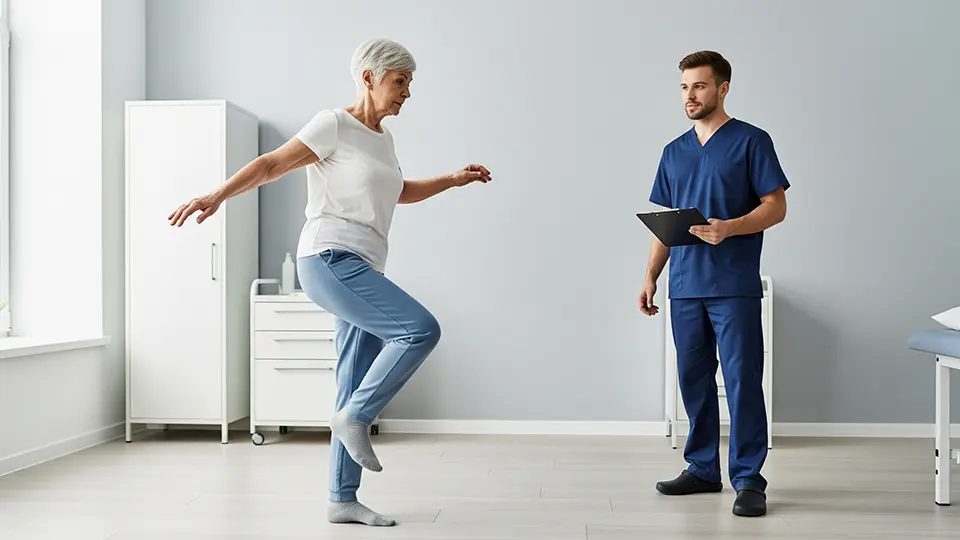
Instruction: “Stand on one foot for 10 seconds.”
Scoring Tip: Most difficult task. Even a few seconds of balance earns some points. Time the attempt.
🧮 How to Score the Berg Balance Scale
Each task is scored from 0 (cannot perform) to 4 (normal performance)
Total Maximum Score: 56
Use the score sheet to document observations immediately
Don’t “coach” or give feedback mid-task (except for safety)
📊 Interpreting the Scores
| Total Score | Interpretation | Fall Risk |
|---|---|---|
| 41 – 56 | Independent | Low fall risk |
| 21 – 40 | Walking with assistance | Moderate fall risk |
| 0 – 20 | Wheelchair bound or severe imbalance | High fall risk |
🔎 Clinical Tip: A change of 8 points or more between assessments is considered clinically significant.
Download: Berg Balance Scale PDF
Need a printable score sheet?
Download here: 📄Expanded_Berg_Balance_Scale_Guide
This includes:
Score chart
Task checklist
Scoring instructions
✅ Benefits of Using the Berg Balance Scale in Clinical Practice
The Berg Balance Scale (BBS) is widely adopted by physiotherapists, occupational therapists, and rehab professionals due to its proven clinical relevance and numerous benefits. Below are key reasons why it’s considered essential in assessing balance:
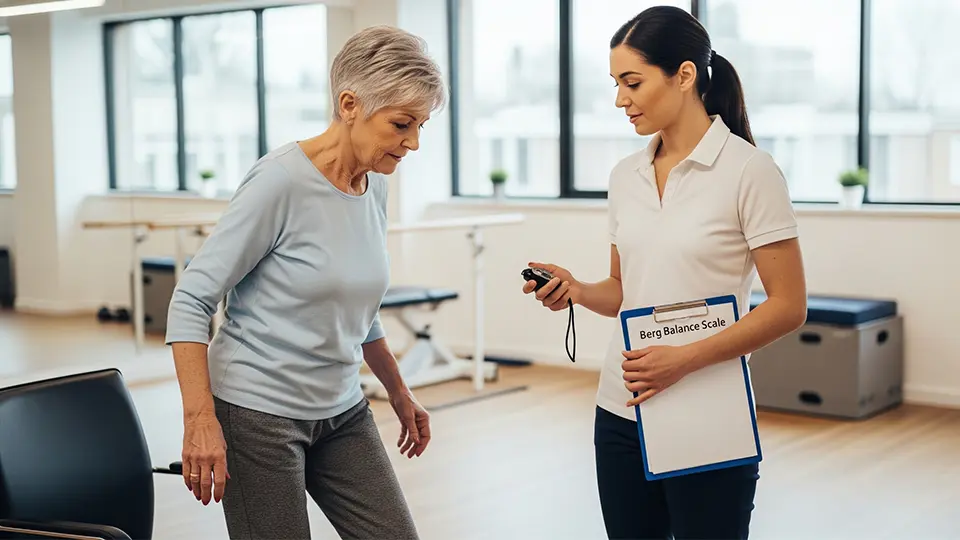
1. Quantifiable and Objective
The BBS provides a numerical score that clearly quantifies a patient’s balance ability. This objectivity is useful for:
Documenting baseline status
Monitoring progress over time
Supporting decisions about discharge or progression of care
2. Evidence-Based Tool
It is one of the most researched clinical balance assessments, with numerous studies validating its:
High inter-rater and intra-rater reliability
Predictive value for fall risk
Responsiveness to rehabilitation programs
3. Applicable to a Wide Range of Populations
The BBS is versatile and can be used for:
Older adults (fall risk screening)
Stroke survivors
Parkinson’s disease
Post-surgical orthopedic rehab
Multiple sclerosis, TBI, and vestibular disorders
4. Fall Risk Prediction
One of the strongest benefits is the ability to stratify patients by fall risk:
Low risk (scores ≥ 41)
Moderate risk (scores 21–40)
High risk (scores ≤ 20)
This helps in tailoring fall prevention strategies, interventions, or referrals.
5. Supports Goal Setting
Clinicians can use BBS results to:
Set SMART goals based on measurable outcomes
Communicate progress to patients and families
Support insurance or rehabilitation documentation with objective data
6. Fast and Inexpensive
Unlike high-tech assessments, the BBS:
Requires no expensive equipment
Takes only 15–20 minutes to complete
Can be repeated frequently with minimal setup
7. Boosts Patient Motivation
Scoring and visual progress help patients:
Understand their current balance limitations
Stay engaged in therapy through visible milestones
Celebrate improvements (e.g., “You improved by 10 points!”)
Call-to-Action (CTA)
Get your balance score now with our free Berg Balance Scale calculator.
➡️Berg Balance Scale Online Calculator | Free Physiotherapy digital Tool
Need professional help? Book a session with our expert physiotherapists at PhysioRehabSolution.com.
FAQs About the Berg Balance Test
Can I use the Berg Balance Scale at home?
Yes, but it’s recommended to have a trained caregiver or physio supervise.
What’s a normal Berg Balance Score?
Healthy adults often score 50–56. Scores below 45 suggest a higher fall risk.
Is this test suitable for stroke patients?
Absolutely. It’s one of the best tools for tracking stroke rehabilitation and functional balance.
Is the Berg Balance Scale suitable for all age groups?
The BBS is primarily validated for older adults, but it can also be used for individuals aged 18+ with conditions affecting balance—such as stroke, Parkinson’s disease, or MS. However, for children or athletes, other specialized balance tools may be more appropriate.
Can the BBS predict fall risk?
Yes, BBS scores are highly predictive of fall risk.
A score below 45 typically indicates a high fall risk.
The lower the score, the higher the likelihood of falls.
How often should the BBS be performed in a rehab setting?
It depends on the condition. In post-stroke or post-op rehab, it’s typically administered:
At initial assessment
After 2–4 weeks
At discharge
For long-term conditions, reassess every 3 months or when there’s a change in mobility.
What is the difference between BBS and Tinetti test?
BBS assesses static balance in a structured, graded format.
Tinetti (POMA) evaluates both gait and balance and includes a walking assessment.
Use BBS for precise balance tracking; use Tinetti when gait is a concern.
Can the BBS be self-administered at home?
No. The BBS must be conducted by a trained professional (physiotherapist, OT, etc.) to ensure safety and scoring accuracy. Some activities pose fall risks if attempted without supervision.
How long does it take to complete the BBS?
On average, it takes 15–20 minutes, depending on the patient’s condition and mobility level.
What kind of equipment is needed for the BBS?
Basic clinical equipment:
Standard chair with armrests
Stopwatch
Object to pick from the floor
Step/stool (~20 cm height)
Ruler or measuring tape
No high-tech tools required.
What conditions is the Berg Balance Scale most commonly used for?
Stroke rehabilitation
Parkinson’s Disease
Multiple Sclerosis (MS)
Post-hip/knee surgery
Geriatric fall risk assessment
Traumatic Brain Injury (TBI)
General deconditioning in elderly patients
